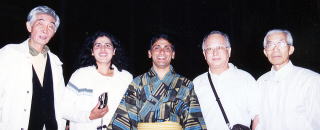Letter from Nepal
“How have you been? Since the beginning of September I have felt I should
write a “Letter from Nepal”. Unfortunately, I didn’t have enough time,
being busy with other businesses. But I have been looking into Hansen’s
disease because I’m involved in patient activities. Here’s the result,
which I hope will be helpful.
Best regards,
Yasuo Hirata
Hansen’s Disease in Nepal
Hansen’s Disease is regarded as one of the illness, which should be exterminated
in respect of public health in Nepal. According to the survey carried out
by WHO, the number of Nepal is within 10 as of 1998. A medical treatment
method wasn’t developed before 1965. After 1965 the government began to
make every effort. As the result, MDT was started in 1982 and is still
used in 70 out of 75 counties. Thanks to this treatment, the rate of new
cases is on decrease every year. Now that the government set its aim, as
WHO suggested, of “eradicating Hansen’s Disease by 2000”, it is tackling
the disease seriously, promoting MDT. In Nepal, the measures against the
disease are included in general health policy. Head officers of the regional
health center called‘Health Post’ are responsible for detecting and treating
the disease. There are, however, some difficulties; because two-thirds
of the country is mountainous, which make traffic and communication hard.
In addition, the number of doctors and nurses engaged in the disease is
very small. Prejudice and discrimination still remain and early detection
and treatment are still difficult. The government has taken the step of
organizing and helping some associations, such as the Nepal Hansen’s Disease
Association and so on. With all these efforts, the government encourages
doctors and nurses to train themselves better and extend campaigns, one
of them is “Campaign to Exterminate Hansen’s Disease”.
Hansen’s Disease, in Case of Nepal
aim of WHO as for the breakout : 1/10,000 by 2000 
rate of breakout: 6.2/ 10,000 as of 1996
5.9/ 10,000 as of 1997
5.3/ 10,000 as of 1998
number of the patients: 12,540
of the completely healed: 47,308
of newly patients: 7,446
rate of newly detected patients: 31,49/1000,000
(as of September 1998 according to the survey of WHO)
National
Flag of Nepal
The
Moon, the upper part, means the royal family and the Sun,
the lower
part, Prime Minister. They represent everlasting the nation’s prosperity.
The design is rare, that the
Sun and the Moon are white to a red background with a dark blue border.
Thanks to Mr. Hirata, we’ve got to know more about Nepal.
Therefore we introduce Nepalese members of the Meguro UNESCO Association.
Ms. Menandhar Gyanu Kato
Gyanu has been introduced several times in the Short News.
She got married to Mr. Kato, devoted husband in Katmandu.
She was also a one-day teacher of international understanding at Ochiai
Third Elementary School in Shinjuku. Do you remember her?
At UNESCO Bazaar on October 18th, she will serve us Nepal curry and rice.
Why don’t you have some? Her family runs a hotel in Katmandu. Her brother
welcomes especially Japanese travelers. Now she studies Japanese very hard
to get a 2nd grade of Japanese Qualification Test. Let’s welcome her again.
Hotel: Red Planet THEML. Katmandu
 Mr. Adhikari is Ph.D candidate at Shinshu University. He took part in the
Retreat this year and two years ago. He and his friends talked late at
night and still there remains a lot they want to talk about. He is a graduate
of prestigious college in Nepal. When Adviser Tajima visited Nepal, he
had the honor to meet President. Both of Mr. & Mrs. Adhikari are fluent
in Japanese. Bimala is excellent
Mr. Adhikari is Ph.D candidate at Shinshu University. He took part in the
Retreat this year and two years ago. He and his friends talked late at
night and still there remains a lot they want to talk about. He is a graduate
of prestigious college in Nepal. When Adviser Tajima visited Nepal, he
had the honor to meet President. Both of Mr. & Mrs. Adhikari are fluent
in Japanese. Bimala is excellent(from left) Mr.Hattori, Mr&Mrs.Adhikari, Mr.Okusawa, Mr.Tajima
180-6へ

